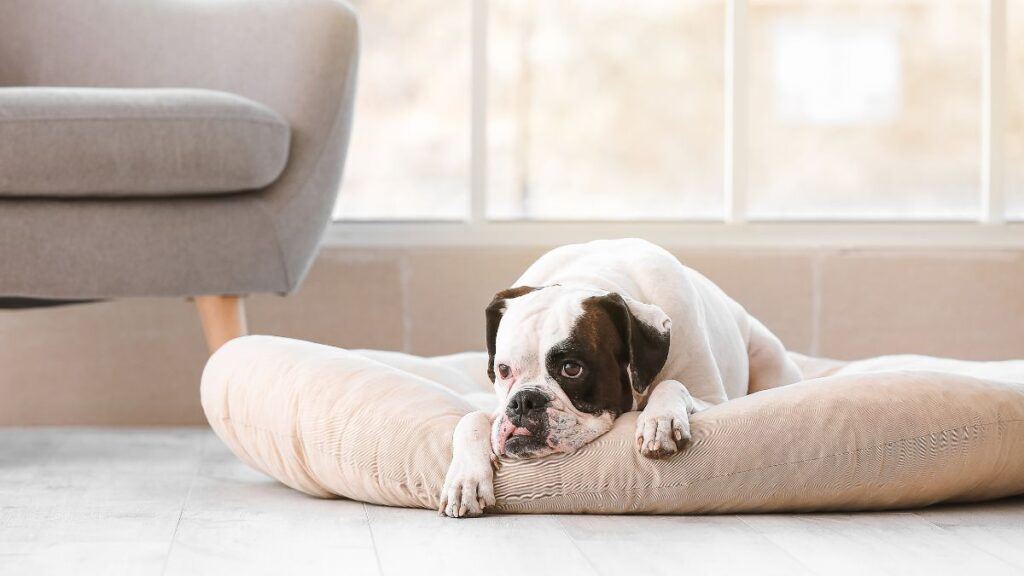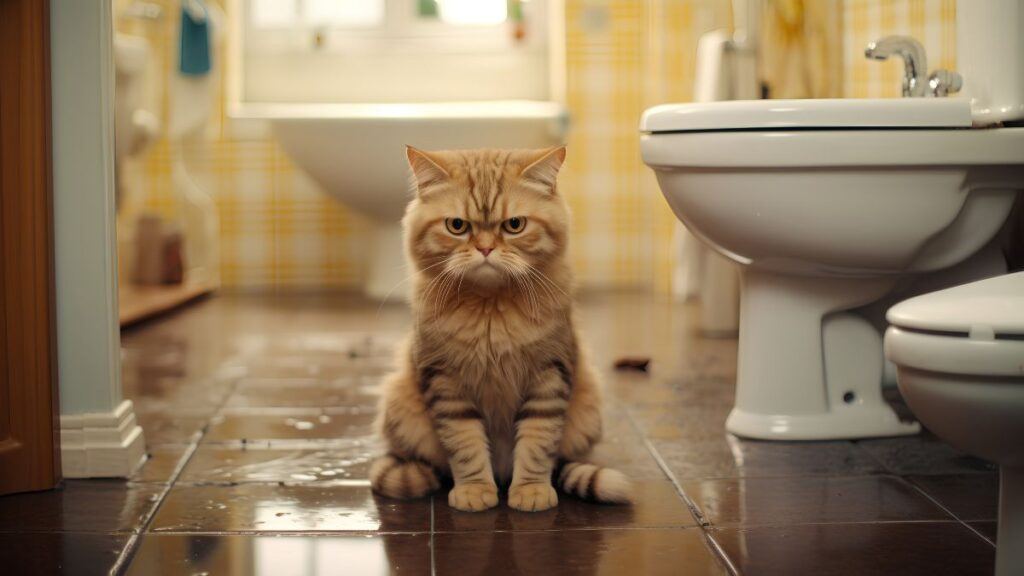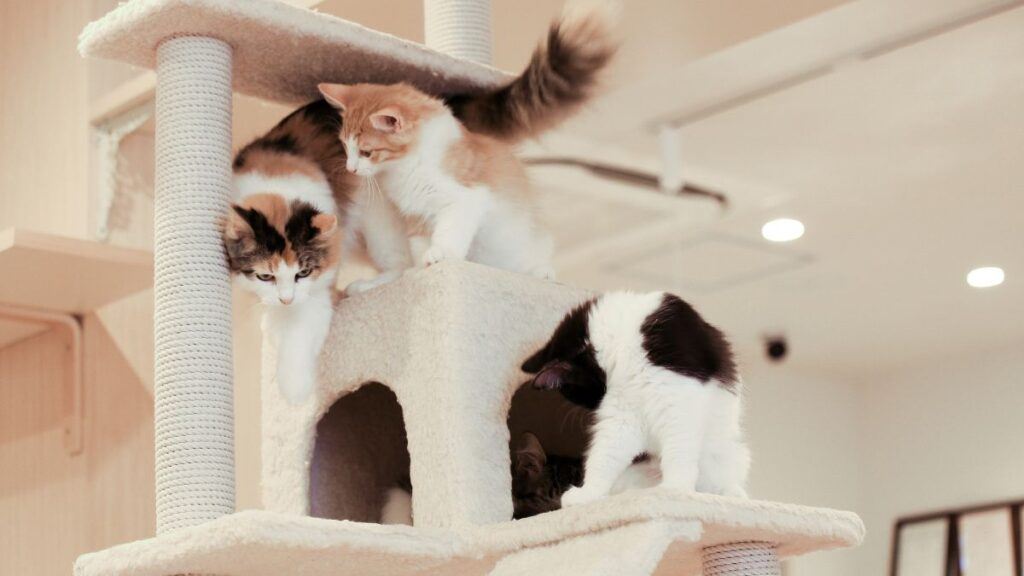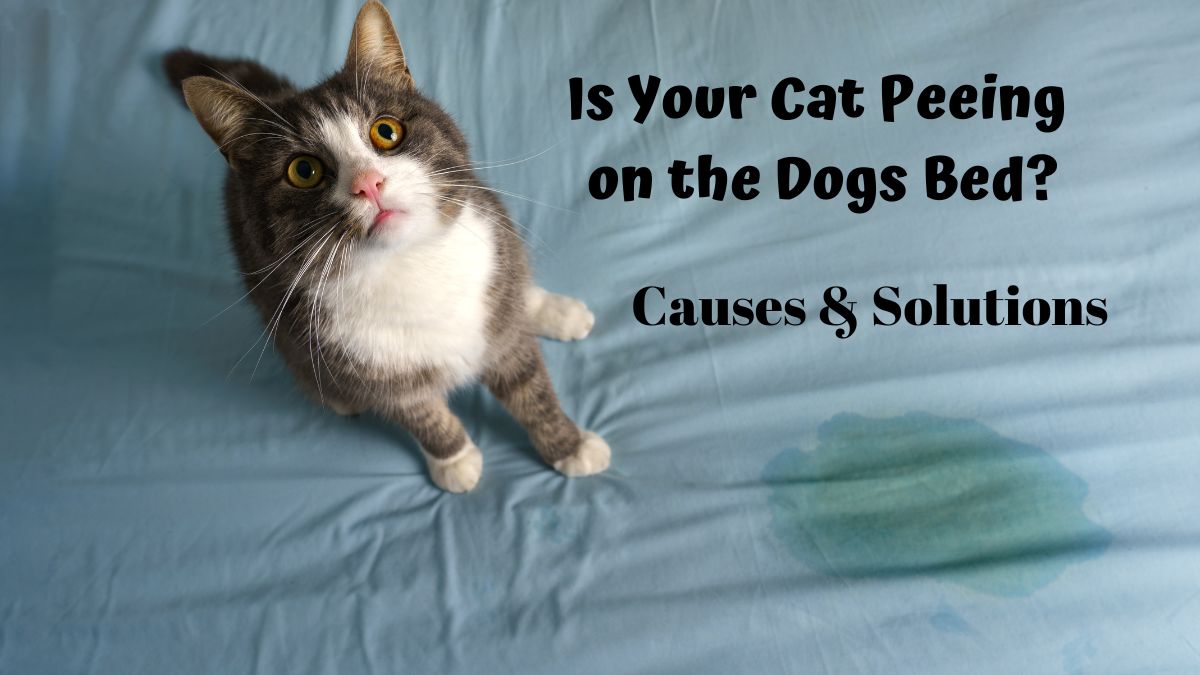Cats and dogs can make great companions, but when a cat starts peeing on the dog’s bed, it can cause tension and frustration in the household.
Various factors, including territorial issues, stress, or medical problems, can cause this behavior. It is essential to address the issue immediately to prevent it from becoming a habit.
Is Your Cat Peeing on the Dog’s Bed?

- Marking Their Territory
- Stress
- Medical Issues
One possible reason for a cat to pee on a dog’s bed is territorial marking.
Cats are known for being territorial animals, and they may mark their territory by urinating on objects belonging to other household pets.
Another possible cause is stress. Cats may feel stressed if there are changes in their environment or routine, such as a new pet or a move to a new home.
Medical issues, such as a urinary tract infection, may also be a factor.
If your cat is peeing on your dog’s bed, it is crucial to take action to address the behavior.
This may include providing separate sleeping areas for your pets, addressing any underlying medical issues, and working to reduce stress in your cat’s environment.
Resolving this issue and restoring harmony to your household is possible with patience and persistence.
Understanding Cat Behavior

Cats are creatures of habit, and their behavior is influenced by various factors, including their environment, stress levels, and past experiences.
Understanding the reasons behind a cat’s behavior can help pet owners address issues such as a cat peeing on a dog’s bed.
Territorial Marking and Stress
Cats are known for their territorial marking habits, including spraying or urinating in certain areas. This behavior is often triggered by stress or a need to establish their territory.
When a cat feels threatened or anxious, they may mark their territory as a way to assert their dominance and establish a sense of security.
Sometimes, a cat may view a dog bed as a desirable location to mark their territory, especially if they feel the bed belongs to a rival or an intruder.
To prevent this behavior, pet owners should ensure their cat has a comfortable environment with plenty of hiding spots, scratching posts, and toys.
This can help reduce stress levels and prevent territorial marking.
Litter Box Habits
Another common reason for a cat peeing on a dog bed is related to their litter box habits.
Cats are known for being fastidious creatures and may avoid using a litter box that is dirty or in an inconvenient location.
If a cat’s litter box is not cleaned regularly or placed in a noisy or high-traffic area, they may seek alternative locations to relieve themselves.
To address this issue, pet owners should ensure that their cat’s litter box is cleaned regularly and is located in a quiet and private area.
Providing multiple litter boxes in different areas of the home may also be helpful to give the cat more options.
Sometimes, a cat may habitually be peeing outside their litter box, even after the underlying issue has been addressed.
These repeat offenders may require additional training or behavior modification techniques to break the habit.
Related: Are Corgis Good with Cats?
Medical Concerns

Common Health Issues
Cats may pee on dog beds due to underlying medical conditions. The most common medical problem associated with inappropriate urination is a urinary tract infection (UTI).
UTIs can cause pain and discomfort when urinating, leading the cat to avoid the litter box and urinate in other areas of the house, including on dog beds.
Other health problems that may cause a cat to pee on a dog bed include bladder infections and kidney disease.
Signs of Medical Problems
It is essential to rule out any underlying medical condition. Signs of a medical problem may include frequent urination, straining to urinate, blood in the urine, and unusual behavior.
If a cat exhibits any of these symptoms, it is important to take them to the vet for a check-up.
A clean bill of health from the vet does not necessarily mean that the cat is not experiencing a medical problem.
In some cases, cats may have an underlying medical condition that is not easily detected through routine tests.
Suppose a cat continues to pee on a dog bed even after receiving a clean bill of health.
In that case, it may be necessary to consult with a veterinary behaviorist to address any behavioral issues that may be contributing to the problem.
It is important to take any unusual behavior from a cat seriously and seek medical attention if necessary.
Address any underlying medical conditions and work with a veterinary behaviorist if needed.
Environmental Factors

Multi-Cat Households
Cats are territorial animals, and conflicts may arise between cats in multi-cat households over resources such as litter boxes, food, and sleeping areas.
If a cat feels threatened or stressed, it may pee on the dog’s bed to mark its territory.
To prevent this, it is recommended to provide multiple litter boxes, one for each cat plus an additional one, and place them in different locations throughout the house.
This will give each cat its designated area and reduce the likelihood of conflicts.
Changes in the Home
Home environment changes can also cause cat stress, leading to inappropriate elimination. For example, introducing a new baby, pet, or cat can be stressful for a cat and cause it to act out.
To prevent this, it is recommended to introduce new pets or cats slowly and gradually, allowing the cats to get used to each other’s scent and presence.
Providing additional litter boxes and placing them in different locations can help reduce stress.
It is also important to note that the litter box’s location can significantly affect a cat’s behavior.
If the litter box is in a busy or stressful area, such as the living room or near the dog’s bed, the cat may avoid using it and pee elsewhere.
Therefore, it is recommended to place the litter box in a quiet and private area of the home, away from stressful situations.
Behavioral and Training Solutions
Positive Reinforcement Techniques
One effective way to stop a cat from peeing on a dog bed is to use positive reinforcement techniques.
This involves rewarding the cat for good behavior, such as using their litter box, rather than punishing them for bad behavior.
Punishment can often worsen the problem and cause the cat to become more anxious and stressed.
When the cat uses their litter box, give them a treat or praise them with a soothing voice. This will help them associate good behavior with positive rewards.
If the cat pees on the dog bed, do not punish them. Instead, clean up the mess and redirect their attention to their litter box.
With consistency and patience, the cat will learn that using the litter box is the desired behavior.
Creating a Cat-Friendly Space
Another solution to stop a cat from peeing on a dog bed is to create a cat-friendly space. This can include providing the cat with their own bed, cat tree, and toys.
It is also important to ensure the cat has access to a clean litter box and tray. A dirty litter box can be a behavioral problem and can cause the cat to urinate in inappropriate places.
It may be helpful to provide the cat with a separate room or area where they can feel safe and secure. This can help reduce their stress and anxiety, which can be a trigger for inappropriate urination.
By creating a cat-friendly space and providing the cat with the necessary resources, you can help prevent them from peeing on the dog bed.
Cleaning and Prevention
Removing Odors and Stains
A cat pees on a dog bed can leave an unpleasant odor and stain behind. Owners should act quickly and use an enzymatic cleaner to remove the smell and stain.
Enzymatic cleaners are specifically designed to break down the proteins in urine, eliminating the odor and preventing future marking behavior.
To use an enzymatic cleaner, blot up any excess urine with a clean cloth or paper towel. Then, saturate the area with the cleaner and let it sit for at least 15 minutes.
After that, blot up the excess cleaner and let the area air dry. Repeat the process if necessary.
If the bed is machine washable, owners can also add an enzyme-based cleaner to the wash cycle. Use warm water and a cup of vinegar to help eliminate the smell of cat urine.
Avoid using bleach or fabric softeners, which can damage the bed and worsen the smell.
Preventive Measures
Owners can take several measures to prevent cats from peeing on dog beds. First, make sure each pet has their own designated bed. This will reduce competition and territorial marking behavior.
Owners can also try placing the dog bed in a different location, away from litter boxes and food bowls. Cats prefer to be eliminated separately from their food and water sources.
Finally, owners can use deterrents, such as motion-activated sprays or aluminum foil, to discourage cats from getting on the bed.
These methods can be effective, but it is important to remember that they are not a substitute for proper training and supervision.
Following these cleaning and prevention tips, owners can keep their dog’s beds clean and fresh-smelling, preventing future accidents.
Conclusion – Cat Peeing on Dog Bed
Dealing with a cat peeing on a dog’s bed can be frustrating and concerning for pet owners.
By understanding the common reasons behind this behavior, such as territorial marking, stress, or medical issues, owners can take proactive steps to address the problem.
It’s important to seek guidance from a veterinarian to rule out any underlying health issues and to implement strategies to create a harmonious environment for both pets.
With patience, consistency, and proper management, it is possible to mitigate or resolve the issue of a cat peeing on a dog’s bed, ultimately fostering a peaceful coexistence between furry companions.
Introducing Cory Haasnoot, a devoted father, loving husband, and enthusiastic cat lover. As a key content creator for CatFurLife.com, Cory blends his family values and passion for felines into engaging and informative content. He brings a unique perspective to the site, sharing cat care tips and how cats can enrich family life and bring joy to households.

